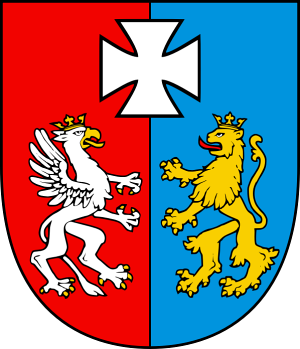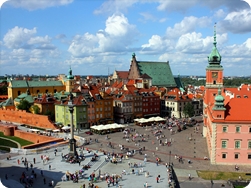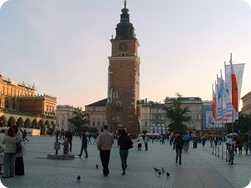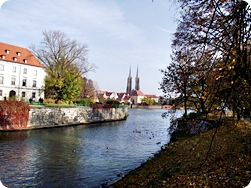
Województwo Podkarpackie
 Podkarpackie, (polish - województwo podkarpackie) the Sub-Carpathian Province, located in the extreme south eastern corner of Polska. Woj Podkarpackie, means underneath the Carpathians.
Podkarpackie, (polish - województwo podkarpackie) the Sub-Carpathian Province, located in the extreme south eastern corner of Polska. Woj Podkarpackie, means underneath the Carpathians.
The region's neighbours are the Lublin Province to the north, the Little Poland Province, Malopolska, to the west, and the Holy Cross Province, Świętokrzyskie Voivodeship, to the north west. The Province of Podkarpackie has an international border with Ukraine, 236 km border, on the east and Slovakia, 134 km border, on the south.
Podkarpackie occupies an area of 17,900 sq km (5.7% of the country's area) and has a population of about 2.1 million people (5.5% of the country's population). The capital of the region is Rzeszów with a population of 165,000, there are 45 towns and almost 2,200 villages, divided into 20 rural and 4 town districts. Arable lands in the region are: 945.6 ha, which constitutes 52.8% of the region's total area.
The province of Podkarpackie includes the plains of the Sandomierz Valley in the Carpathian foothills of the Low Beskid Mountains and the Bieszczady National Park. The region is mostly hilly or mountainous except for its north western corner which is rather flat. It is one of the most wooded Polish provinces covering about 35.9% of the total area of the region.
The Carpathian Mountains or Carpathians are a range of mountains forming an arc of roughly 1,500 km across Central Europe and Eastern Europe, making them the largest mountain range in Europe.
Wislok is a river in south-eastern Poland, a tributary of the San River with a length of 205 kilometres, the 18th longest and has a basin area of 3,528 sq. km. totally within Poland. The Wislok valley could have been an important trade route and human settlements are thought to have existed as early as 9th or 10th century. The Wislok Valley was one of the strategically important Carpathian rivers that were bitterly contested in the battles on the Eastern Front during World War I.
The Wisloka river is a tributary of the Vistula river and has a length of 164 kilometres making it the 26th longest in Poland, the basin area is 4,110 sq. km. Tributaries of Wisloka river are; the Jasiolka, Tuszymka and the Wielopolka.
The San river in south eastern Poland and western Ukraine, and is a tributary of the Vistula River, with a length of 433 km and a basin area of 16,861 km. It is the 6th longest river in Poland. The San has its source in the Carpathian Mountains near the village of Sianky, Ukraine. It is located a few kilometres from the border with Poland, for approximately its first 50 km, in the south-eastern part of Bieszczady, and has an elevation of 900 metres, on the Polish-Ukrainian border.
Transport
Two international highways pass through the Podkarpackie province: the E–40, from Germany through Wrocław, Kraków and Rzeszów to Ukraine and the E–371, from Warsaw passing through Rzeszów to the country of Slovakia. The total length of domestic roads in the Podkarpackie region is 719 km.
In Jasionka, near to Rzeszów, there is an international airport, The International Rzeszów-Jasionka Airport. Other local airports are located in: Mielec, Turbia near to Stalowa Wola, which is only currently used for sport and training flights and Krosno.
Economy and Industry
The Podkarpackie Science and Technology Park at Rzeszów was established by an agreement, signed on 19th of May 2003 between; the Podkarpackie regional government, Rzeszów District authorities, Rzeszów City Council, the Rzeszów Technical University and Rzeszów University.
In the Podkarpackie province, there are two Special Economic Zones: the Euro-Park at Mielec and the Euro-Park at Wisłosan.
Aviation Valley is known for a highly developed aviation industry including pilot training centres. It has a high concentration of aviation companies and is strengthened by research and development facilities, education and training infrastructure.
Near to Tarnobrzeg there are sulphur deposits and oil and gas has been found in the Sub-Carpathians. At Jarosław on the San River there is a clothing and food industry and a large glass works.
Other industries include; automotive, electronics, electrical engineering, tourism infrastructure, textile, agri-food, cosmetics and pharmaceutical.
Tourism and Culture
The Podkarpackie is a great region to visit, because it has been shaped by its history. Located in the borderland. The rich history and centuries–old coexistence of different ethnic groups has resulted in the regions cultural qualities enhanced by the richness of the natural environment. There are many castles and historical sites to keep the visitor happy. Horse-riding, skiing, water sports, mountaineering, hunting and other activities are provided within the Province.
The jewels of the Podkarpackie Province are the Bieszczady Mountains and the Bieszczady National Park, a European oasis of nature and walkers paradise, concealing almost 500 years’ of material remains associated with the Boykos, the Poles and the Jews, who have lived in the region. The Beskid Niski (the Low Beskid) has much to offer the tourist, especially on the Higher Wisłok Valley, where the dominant ethnic group were once the Łemkowie (the Lemkos). The Pogórze Strzyżowsko–Dynowskie (the Strzyżów–Dynów Foothills) and the Pogórze Przemyskie (the Przemyśl Foothills) are known for their grand landscapes. Also the northern part of the province: the Kotlina Sandomierska (the Sandomierz Basin) and its neighbour, the Roztocze, have many cultural activities.
In the Podkarpackie, there are two theaters: The Wanda Siemaszkowa Theater in Rzeszów and The “Maska” Theater also in Rzeszów. The A. Malawski Philharmonic in Rzeszów has existed for about 50 years, and it has obtained significant artistic achievements during that time. The “Estrada Rzeszowska” Art Institution is promoted in all areas of the Podkarpackie province.
Podkarpackie - David's Travel Guides




